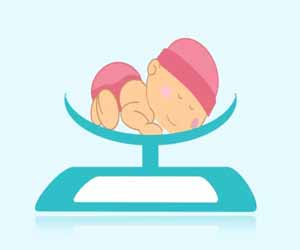- Home
- Editorial
- News
- Practice Guidelines
- Anesthesiology Guidelines
- Cancer Guidelines
- Cardiac Sciences Guidelines
- Critical Care Guidelines
- Dentistry Guidelines
- Dermatology Guidelines
- Diabetes and Endo Guidelines
- Diagnostics Guidelines
- ENT Guidelines
- Featured Practice Guidelines
- Gastroenterology Guidelines
- Geriatrics Guidelines
- Medicine Guidelines
- Nephrology Guidelines
- Neurosciences Guidelines
- Obs and Gynae Guidelines
- Ophthalmology Guidelines
- Orthopaedics Guidelines
- Paediatrics Guidelines
- Psychiatry Guidelines
- Pulmonology Guidelines
- Radiology Guidelines
- Surgery Guidelines
- Urology Guidelines
More a baby weighs at birth, more are chances of childhood allergies

Allergic diseases are developmentally programmed by early-life exposures. However, evidence from preclinical studies suggests that intrauterine growth restriction is protective against later inflammatory responses to allergens.
Researchers in a new study have found that the more a baby weighs at birth relative to its gestational age the higher the risk they will suffer from a childhood food allergy or eczema, although not hay fever.This implies that intrauterine growth restriction protects against allergic diseases in human subjects The study has been published in the Journal of Allergy and Clinical Immunology.
“We analysed the associations between birth weight, corrected for gestational age, and the incidence of allergic diseases in children and adults,” says Dr Gatford lead researcher from the University of Adelaide’s Robinson Research Institute .
“For each kilogram increase in birth weight, there was a 44 percent increase in the risk that a child had food allergies or a 17 percent increase in the risk that they had eczema.
“We found that increased birth weight has no influence on the risk of childhood hay fever.”
Dr. Kathy Gatford from the University of Adelaide’s Robinson Research Institute led a team of scientists that carried out a systematic review assessing past studies in humans. After screening more than 15,000 studies, they identified 42 that included data on more than two million allergy sufferers.
The researchers analysed studies that included over 2.1 million people affected by allergic dermatitis, commonly known as eczema, nearly 70,000 people affected by food allergies and over 100,000 people with allergic rhinitis or hay fever. Most of the studies were in children from developed countries and most were European.
“Allergic diseases including eczema, hay fever, food allergies, anaphylaxis, and asthma are estimated to affect 30–40 percent of the world’s population,” says Dr Gatford.
“It is increasingly clear that genetics alone do not explain risks of developing allergies, and that environmental exposures before and around birth can program individuals to increased or decreased risk of allergies,” says Dr Gatford.
“Although restricted growth before birth – intra-uterine growth restriction (IUGR) – is associated with increased risks of many diseases in later life, it appears to protect a child against the risk of developing allergic responses.
“The main message for mums is those big babies are at increased risk of allergy, so mothers with big babies should seek advice on modifying environmental factors to reduce those risks.”
Most of the allergies in these studies were assessed in young children. The researchers say further studies investigating allergies in older children, adolescents, and adults are needed to help inform how and when restricting intra-uterine growth affected a person’s immune development and their susceptibility to allergic disease.
The study was initiated and planned by former University of Adelaide PhD student Dr. Amy Wooldridge, now based at the University of Alberta in Edmonton, Canada.
For further reference log on to :
Relationship between birth weight or fetal growth rate and postnatal allergy: A systematic review
DOI: https://doi.org/10.1016/j.jaci.2019.08.032

Disclaimer: This site is primarily intended for healthcare professionals. Any content/information on this website does not replace the advice of medical and/or health professionals and should not be construed as medical/diagnostic advice/endorsement or prescription. Use of this site is subject to our terms of use, privacy policy, advertisement policy. © 2020 Minerva Medical Treatment Pvt Ltd